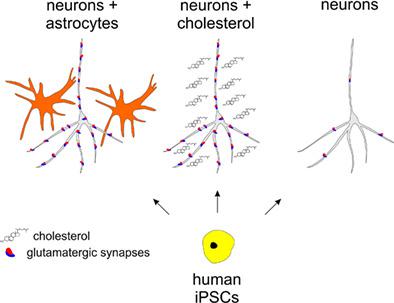Our official English website, www.x-mol.net, welcomes your feedback! (Note: you will need to create a separate account there.)
Astrocyte lineage cells are essential for functional neuronal differentiation and synapse maturation in human iPSC‐derived neural networks
Glia ( IF 5.4 ) Pub Date : 2019-06-27 , DOI: 10.1002/glia.23666 Simon D. Klapper 1 , Pretty Garg 1, 2 , Sushma Dagar 1 , Kerstin Lenk 3 , Kurt Gottmann 1 , Katja Nieweg 1, 2
Glia ( IF 5.4 ) Pub Date : 2019-06-27 , DOI: 10.1002/glia.23666 Simon D. Klapper 1 , Pretty Garg 1, 2 , Sushma Dagar 1 , Kerstin Lenk 3 , Kurt Gottmann 1 , Katja Nieweg 1, 2
Affiliation

|
Human astrocytes differ dramatically in cell morphology and gene expression from murine astrocytes. The latter are well known to be of major importance in the formation of neuronal networks by promoting synapse maturation. However, whether human astrocyte lineage cells have a similar role in network formation has not been firmly established. Here, we investigated the impact of human astrocyte lineage cells on the functional maturation of neural networks that were derived from human induced pluripotent stem cells (hiPSCs). Initial in vitro differentiation of hiPSC‐derived neural progenitor cells and immature neurons (glia+ cultures) resulted in spontaneously active neural networks as indicated by synchronous neuronal Ca2+ transients. Depleting proliferating neural progenitors from these cultures by short‐term antimitotic treatment resulted in strongly astrocyte lineage cell‐depleted neuronal networks (glia− cultures). Strikingly, in contrast to glia+ cultures, glia− cultures did not exhibit spontaneous network activity. Detailed analysis of the morphological and electrophysiological properties of neurons by patch clamp recordings revealed reduced dendritic arborization in glia− cultures. In addition, a reduced action potential frequency upon current injection in pyramidal‐like neurons was observed, whereas the electrical excitability of multipolar neurons was unaltered. Furthermore, we found a reduced dendritic density of PSD95‐positive excitatory synapses, and more immature properties of AMPA (alpha‐amino‐3‐hydroxy‐5‐methyl‐4‐isoxazolepropionic acid) miniature excitatory postsynaptic currents (mEPSCs) in glia− cultures, suggesting that the maturation of glutamatergic synapses depends on the presence of hiPSC‐derived astrocyte lineage cells. Intriguingly, addition of the astrocyte‐derived synapse maturation inducer cholesterol increased the dendritic density of PSD95‐positive excitatory synapses in glia− cultures.
中文翻译:

星形胶质细胞谱系细胞对于人iPSC衍生的神经网络中功能神经元分化和突触成熟至关重要
人星形胶质细胞与鼠类星形胶质细胞在细胞形态和基因表达上有很大的不同。众所周知,后者通过促进突触成熟在神经元网络的形成中具有重要作用。然而,尚未确定人类星形胶质细胞谱系细胞在网络形成中是否具有相似的作用。在这里,我们调查了人类星形胶质细胞谱系细胞对神经网络功能成熟的影响,这些神经网络源于人类诱导的多能干细胞(hiPSC)。hiPSC衍生的神经祖细胞和未成熟神经元(glia +培养物)的初始体外分化导致自发活跃的神经网络,如同步神经元Ca 2+所示。瞬变。通过短期抗有丝分裂处理使这些培养物中的增殖性神经祖细胞耗竭,导致星形胶质细胞谱系细胞耗竭的神经元网络(胶质细胞培养物)强烈缺失。令人惊讶的是,与神经胶质细胞+文化相反,神经胶质细胞-文化没有表现出自发的网络活动。通过膜片钳记录对神经元的形态和电生理特性进行的详细分析显示,胶质细胞培养物中树突状树突减少。此外,观察到电流注入锥体状神经元时动作电位频率降低,而多极神经元的电兴奋性未改变。此外,我们发现PSD95阳性兴奋性突触的树突密度降低,以及胶质细胞培养物中AMPA(α-氨基-3-羟基-5-甲基-4-异恶唑丙酸)微型兴奋性突触后电流(mEPSC)的更不成熟的特性,表明谷氨酸能突触的成熟取决于hiPSC-星形胶质细胞谱系细胞。有趣的是,在星形胶质细胞培养物中,星形胶质细胞衍生的突触成熟诱导剂胆固醇的添加增加了PSD95阳性兴奋性突触的树突密度。
更新日期:2019-06-27
中文翻译:

星形胶质细胞谱系细胞对于人iPSC衍生的神经网络中功能神经元分化和突触成熟至关重要
人星形胶质细胞与鼠类星形胶质细胞在细胞形态和基因表达上有很大的不同。众所周知,后者通过促进突触成熟在神经元网络的形成中具有重要作用。然而,尚未确定人类星形胶质细胞谱系细胞在网络形成中是否具有相似的作用。在这里,我们调查了人类星形胶质细胞谱系细胞对神经网络功能成熟的影响,这些神经网络源于人类诱导的多能干细胞(hiPSC)。hiPSC衍生的神经祖细胞和未成熟神经元(glia +培养物)的初始体外分化导致自发活跃的神经网络,如同步神经元Ca 2+所示。瞬变。通过短期抗有丝分裂处理使这些培养物中的增殖性神经祖细胞耗竭,导致星形胶质细胞谱系细胞耗竭的神经元网络(胶质细胞培养物)强烈缺失。令人惊讶的是,与神经胶质细胞+文化相反,神经胶质细胞-文化没有表现出自发的网络活动。通过膜片钳记录对神经元的形态和电生理特性进行的详细分析显示,胶质细胞培养物中树突状树突减少。此外,观察到电流注入锥体状神经元时动作电位频率降低,而多极神经元的电兴奋性未改变。此外,我们发现PSD95阳性兴奋性突触的树突密度降低,以及胶质细胞培养物中AMPA(α-氨基-3-羟基-5-甲基-4-异恶唑丙酸)微型兴奋性突触后电流(mEPSC)的更不成熟的特性,表明谷氨酸能突触的成熟取决于hiPSC-星形胶质细胞谱系细胞。有趣的是,在星形胶质细胞培养物中,星形胶质细胞衍生的突触成熟诱导剂胆固醇的添加增加了PSD95阳性兴奋性突触的树突密度。











































 京公网安备 11010802027423号
京公网安备 11010802027423号